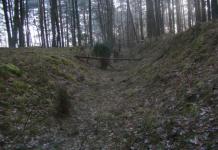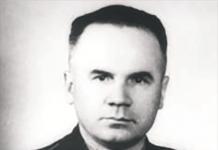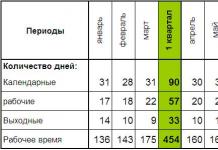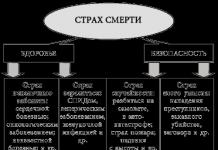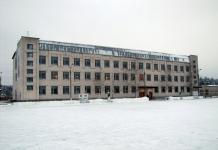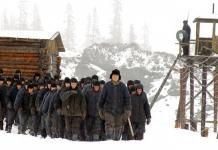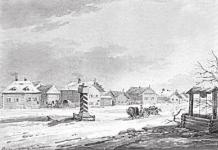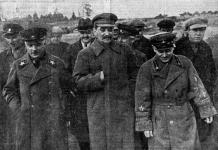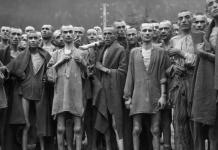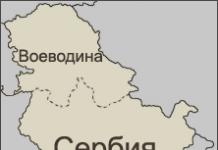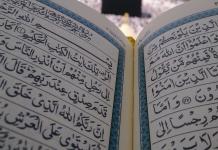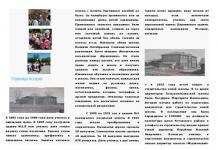Le Corbusier- French architect of Swiss origin, who was also a designer, artist, writer and publicist. He is a pioneer of modernism, a representative of international style architecture, embodied the ideas of functionalism in architecture. The buildings designed by him are located all over the world: in Europe, America, India, Japan.
In an effort to make life easier for the inhabitants of overcrowded cities, Le Corbusier was actively involved in urban planning and was one of the founders of the International Congress of Modern Architecture (CIAM).
Biography
Charles-Edouard Jeanneret-Gris was born on October 6, 1887 in the Swiss town of La Chaux-de-Fonds into the family of an enamel watchmaker.
From childhood, young Charles was attracted fine Arts and he entered the School of Art in Chaux-de-Fonds under the course of Charles Leplatenier, his teacher of architecture was René Chapalla, who greatly influenced early work. From the moment he entered the school, he began to independently engage in jewelry making, creating enamels and engraving monograms on watch cases.
In his youth, he tried to leave the provincial atmosphere of his native city and traveled around Europe. In September 1907 he made his first trip to Italy, then via Budapest to Vienna, where he stayed for four months and met Gustav Klimt and Josef Hoffmann. He then travels to Paris in 1908, where he finds work in the office of August Perret, a French pioneer in the field of reinforced concrete. All these trips influenced him and began to develop his own architectural style. Between October 1910 and March 1911 he worked near Berlin for the famous architect Peter Behrens, where he may have met Ludwig Mies van der Rohe and Walter Gropius. At that time, he visited the Nursing Home and the monastery attached to him in the Ema Valley, and this greatly affected his position in life. From now on, he began to believe that all people should be able to live quietly and calmly, like monks in their monastery.
Later, in 1911 he traveled to the Balkans and visited Serbia, Bulgaria, Turkey and Greece, he returned with about 80 notebooks full of sketches of what he saw, in particular the Parthenon. He would then praise its forms in his book To Architecture.
During the First World War, Le Corbusier taught at his native art school in Switzerland and returned to Paris only after the war was over. During these four years in Switzerland he worked in the field of theoretical architecture, using modern techniques. Among other things was the Dom-ino House project, a model offering an open plan consisting of concrete slabs supported by the minimum amount reinforced concrete columns along the edges. This design became the basis for most of his structures for the next 10 years.
He soon started his own architectural practice, along with his cousin Pierre Jeanneret. This cooperation lasted until the 1950s, with a break for the years of World War II.
In 1918, Le Corbusier met the cubist painter Amédée Ozenfant, in whom he found a kindred spirit. Ozanfant encouraged him to paint and they began to collaborate. Discarding Cubism as irrational and "romantic", they published their manifesto "After Cubism" and founded a new artistic movement, purism. Ozenfant and Le Corbusier founded the magazine L "Esprit nouveau (New Spirit).
In the first issue of the magazine in 1920, Charles-Edouard Jeanneret took on the pseudonym Le Corbusier (a slightly modified surname of his grandfather), under the auspices of the idea that everyone can create a new self.
In the period from 1918 to 1922, Le Corbusier did not build buildings, concentrating entirely on the theory of purism and painting. And in 1922, together with his cousin Pierre, he opened an architectural studio in Paris. In the 1920s, Le Corbusier designed several villas that made him famous. Almost all of them are located in the vicinity of Paris. All of them are buildings in the modernist style. They started talking about Corbusier, the new aesthetics of the villas excited the minds of the European public. The most notable works are Villa La Roche/Janneret (1924), Villa Stein in Garches (now Vaucreson, 1927), Villa Savoy in Poissy (1929). All of them are distinguished by simple geometric shapes, white smooth facades, horizontal windows, and the use of a reinforced concrete frame. In these structures, Corbusier applied his architect's code - "The Five Starting Points of Architecture".
In 1925, Corbusier and Pierre presented the "Plan Voisin" - a proposal for the restructuring of Paris. The plan provided for the demolition of about 240 hectares of old buildings and the erection of eighteen identical skyscrapers in their place with 50 floors. In this and subsequent plans, Le Corbusier proposed new planning methods to improve the comfort of living in cities, to create green areas and a network of transport routes in them.
In 1940, Le Corbusier closed his Paris workshop and moved to a farm in the Pyrenees. At this time, he was engaged in theoretical developments, in particular, the Modulor proportion system, which he then actively applied in buildings.
After the end of World War II, restoration work began in France, and Le Corbusier participated in them at the invitation of the authorities. In particular, he carried out plans for the reconstruction of the cities of Saint-Dieu (1945) and La Rochelle (1946), which became a new original contribution to urban planning.
For Saint-Dieu, Le Corbusier designed the Claude and Duval (1946-1951) manufactory building - a four-story block with industrial and office premises, with continuous glazing of the facades. During the construction of the Duval manufactory, the so-called "sun cutters" (fr. brise-soleil) were used - special hinged structures invented by Corbusier that protect the glazed facade from direct sunlight. Subsequently, the "sun cutters" became a kind of trademark of Corbusier's buildings, where they perform both a service and a decorative role.
In 1947, construction began on the famous "Marseilles Housing Unit" - an apartment building with complete infrastructure located inside one building.
In 1950, Corbusier began the implementation of his most ambitious project - new capital Punjab state, Chandigarh city. Corbusier developed the administrative center, residential areas with infrastructure, schools, hotels. The city was built over a period of about 10 years. Corbusier himself designed the Capitol, the administrative center of the city. These are the buildings of the Secretariat, the Palace of Justice and the Assembly. Each of them is distinguished by a bright characteristic of the image, powerful monumentality and represents a new word in the architecture of that time.
In the 1950s and 1960s, Le Corbusier was already recognized as an architectural genius. He was inundated with orders, his name thundered around the world. During this time, he built several structures that cemented his title as the number one European avant-garde architect. These are the Ronchamp Chapel in France (1955), the Brazilian Pavilion on the campus in Paris, the La Tourette monastery complex (1957-1960), the Museum building Western art in Tokyo (1959).
One of Corbusier's last major works is the US-built cultural center at Harvard University, the Carpenter Center for the Visual Arts (1959-1962).
In 1928, Corbusier participated in a competition for the construction of the building of the People's Commissariat of Light Industry (House of the Centrosoyuz) in Moscow. It was subsequently built according to his design. The building of the Centrosoyuz was a completely new example of a modern business building solution for Europe. The construction was carried out under the guidance of the architect Nikolai Colli.
In 1928, 1929, in the early thirties, the architect often came to Moscow in connection with construction. Here he met with Soviet cultural figures, in particular with Meyerhold and Eisenstein, and admired the creative atmosphere that prevailed in the country at that time. He was especially impressed by the achievements of the Soviet architectural avant-garde - the Vesnin brothers, Moses Ginzburg, Konstantin Melnikov. Later, Le Corbusier participated in the international competition for the building of the Palace of Soviets for Moscow (1931), for which he made an extremely bold, innovative project.
"Five Points of Architecture"
Le Corbusier's Five Points of Architecture was published in L'Esprit Nouveau in the 1920s. In these seemingly simple rules, Corbusier tried to formulate his concept of modern architecture. Here is their free retelling:
Support pillars. The house is raised above the ground on reinforced concrete pillars, while freeing up space under the living quarters - for a garden or a car park.
Flat roof terraces. Instead of the traditional sloping roof with an attic underneath, Corbusier proposed a flat roof-terrace, on which one could plant a small garden or create a place to relax.
Free layout. Since the walls are no longer load-bearing (due to the use of a reinforced concrete frame), the interior space is completely freed from them. As a result, the interior layout can be organized much more efficiently.
Ribbon windows. Due to the frame structure of the building and the absence, in connection with this, of load-bearing walls, windows can be made of almost any size and configuration, incl. freely stretch them with tape along the entire facade, from corner to corner.
free facade. The supports are installed outside the plane of the facade, inside the house (literally in Corbusier: freely located inside the premises). In this case, the outer walls can be made of any material - light, fragile or transparent, and take any shape.
modulor
modulor is a system of proportions developed by Le Corbusier. He described it as "a set of harmonic proportions commensurate with the scale of man, universally applicable to architecture and mechanics."
Using stone, wood and concrete, you build houses and palaces; this is construction. However, suddenly you touch my heart, my feelings, I am happy, I say: "Beautiful." This is Architecture.
Le Corbusier
The history of modern architecture in the West was written in parallel with the development of modern architecture itself. The best architects of the centuries were also theorists, and therefore researchers and commentators. With all the painful contradictions, with the ups and downs of the development of architecture, the central idea of the architect of the 20th century is revealed: the need for a radical transformation of society, the need to make it harmonious through a decisive impact on the human environment. "Architecture or revolution" - from this opposition of his Le Corbusier concludes: you can avoid the revolution! (How can one not recall the phrase put into the mouth of his hero by M. A. Bulgakov, an artist from the Corbusier generation and, perhaps, equal to him in talent: “Well ... they are people like people ... ordinary people ... in general, they remind former ones ... the housing problem only spoiled them ...”)
The activity of Le Corbusier in terms of influence and breadth of achievements occupies an exceptional place in the development of architecture of the 20th century. He was discussed during his lifetime and after his death. He was called the greatest and most unloved architect of the century. Corbusier himself, with bitterness and dignity, recognized the ability of his art to arouse anger in some cases, enthusiasm in others. The traits of his personality (poeticism, romanticism, a penchant for utopian constructions and possession of a “cold Gallic sense”, Cartesianism, the ability to accurately plan the mode of work and the utmost, selfless return to them) were embodied in his work. In each text, in each construction of the master, both the creative rise of entire epochs and “the finest nuances of the artist’s spiritual world” were reflected.
Le Corbusier worked at a turning point. A sharp increase in population, the need for new construction projects (train stations, airports, stadiums and exhibition halls, transport arteries, factory complexes, etc.), a change in production methods (replacement manual labor mechanical, the use of a conveyor, etc.), a revolutionary change in thinking in connection with scientific and technological progress (suffice it to mention the widespread introduction of electricity, an increase in the speed of transport and the emergence of new means of communication), the addition of closer ties with transport workers, hygienists, climatologists, system of organization of public services - these are just some of the conditions that have become necessary for architects to take into account. But along with the problems, there were also previously unknown opportunities ...
Le Corbusier, actually Charles Edouard Jeanneret-Gris, was born on October 6, 1887 in the city of La Chaux-de-Fonds (Switzerland), located near the border with France. This city, like the community of the same name, is one of the largest watch manufacturers. Today it is included in the UNESCO World Heritage List. The teachers of the kindergarten, to which little Charles was sent by his parents, were guided by the methods of F. Froebel, who encouraged the creative potential of the kids. So the desire to invent and taste were instilled in the boy from a very early age.
Swiss watches have always been considered the best in the world, and it is easy to understand why the family business - an engraver, an enameller, a "designer" (there was no such thing then) of dials, did not arouse opposition from Charles. At the age of 13, he entered the local School of Applied Arts, having received the specialty of a jeweler, watchmaker and engraver.
In 1902 (the young man was only 15 years old), the clock minted by him using silver, steel and gold won an honorary diploma at the international exhibition of decorative arts in Turin. He was not yet 18, when, under the influence and with the blessing of his teacher, Charles Leplatenier and with the help of a professional architect, Charles created his first building - a house for a board member of the Engraver School, Louis Fallet (Villa Falle, 1905). The building was built and decorated in line with an established tradition, with ornaments and decorations. Note that one of the brightest architects of the 20th century did not have a special architectural education(as, indeed, did Mies van der Rohe, Wright and other great ones). In fact, he was self-taught. architectural universities travel, libraries, museums, systematic, deep self-education and, most importantly, creative communication with many leading masters of that time became for him.
So, with the money earned through the first order, Charles Edward took a trip to Italy and Austria-Hungary, studying and sketching the monuments. In Vienna, he met Josef Hofmann, a well-known Austrian architect of the Secession (Modern). In Paris, he worked for two years as a draftsman in the architectural office of Auguste and Gustave Perret, whose work represents the transition from Art Nouveau architecture to functionalism.

In Perret's workshop, the young master "learned what reinforced concrete was" and appreciated it as the material of the future. From October 1910 to March 1911, near Berlin in Neubabelsberg, Janner was an intern in the studio of the German architect, pioneer of functionalism Peter Behrens. Here, at that time (an amazing, significant meeting!) Young Ludwig Mies van der Rohe and Walter Gropius, (“the founding fathers of modernism,” as they will be called later), worked with whom friendship and cooperation were maintained for many years.
In 1911, Charles Eduard continued his cognitive journey through the countries of the Balkans and Asia Minor, carefully studying not only famous monuments, but also folk construction. Subsequently, these observations helped him "illustrate" with examples his own thoughts about the tasks of architecture. Thus, >n imperturbably compared the Parthenon and the car, finding in them a similarity in the principles of standardization of forms, born through careful selection.
In 1914, Jeanneret became the head of his own architectural workshop, fulfilling orders for private houses. Even earlier (1912) the villa Jeanneret-Perret was designed and built - a house for parents. However, the architect considered his truly first independent project to be the house for the local watch magnate - Villa Schwob (1916-1917), or, as it is also called, the Turkish Villa.

Already during this period in his homeland, realizing the great role of architecture in solving social problems, Charles Edouard developed the Dom-Ino project (together with engineer Max Dubois) - the technical idea of a house with standardized cells. On the plan, such buildings looked like dominoes stacked in chains, as happens during a game, and the columns looked like dots on them. In fact, it was the first idea in the history of architecture of a frame house for mass production. But putting forward the problem of standardization here and further, the master did not forget about artistry, believing that the standard is the path to selection, and therefore to improvement.
Since 1917 Jeanneret has been in Paris. Everybody free time he devotes to the theory of architecture and painting. Having joined the still seething life of the "Parisian school", having met the great modernists Picasso, Braque, Léger and others, he himself was ready for heroic experiments. Together with a friend, the French artist Amédée Ozenfant, Jeanneret published the manifesto "After Cubism" (1918), which formulated the main provisions of a new trend in painting - purism. Purist painting turns the subject into an occasion for a sophisticated play of lines, refined generalized silhouettes and color spots. Purists proclaimed the idea of purifying the depicted, replacing it with a plastic symbol, a sign capable of revealing the internal structure of the object. Let's also say that Le Corbusier considered painting as one of the sources of his architectural ideas.
As the architect admitted, the most significant for him, not far from Paris ( early work masters).

Together with Ozenfant Jeanneret, in 1920-1925, he published the journal L’Esprit nouveau, The New Spirit, which became extremely popular for all adepts of the wind of change in art, and led the architecture section in it. On the pages of this radical philosophical and artistic review, he published a lot himself and for the first time signed as Le Corbusier, taking the surname of one of his mother's ancestors. The “new” included, first of all, the idea of rationalism in architecture, which, in its implementation, would have to focus on the degree of functionality, as demanded by designers and car designers. The slogan house is a car for living” becomes for Corbusier a kind of password for marking “friends and foes” in a professional environment. “Machine” is, first of all, for him the product of a smooth surface, a new aesthetic taste and accurate calculation.

A milestone in the biography of Le Corbusier is 1922. He meets Yvonne Galli, whom he marries eight years later, having taken French citizenship. In addition, cooperation with a cousin, the architect Pierre Jeanneret, allowed in 1922 to open a successful design workshop in Paris. Very soon her address - Rue de Sèvres, 35 - became one of the international centers of new architectural thought.
In 1925, the ideas underlying the layout were transferred to the Voisin plan. It proposed demolishing old Paris (240 hectares) to build a business center with 18 50-story skyscrapers for various offices and "undersized" horizontal "bundles" for service purposes, which together would occupy a negligible share of the entire city. The remaining 95% were allocated for wide driveways, pedestrian zones and parks.
Even on the pages of the New Spirit magazine, Le Corbusier published materials about Soviet Russia calling for the establishment diplomatic relations between France and the USSR. In 1928-1930 he made three trips to Russia, where he designed and performed. After winning the 1928 competition, Le Corbusier was commissioned to design a building designed for 3,500 employees. This building, which came to life in 1928-1936, became for him the first large public building to be realized. All comfort conditions were provided, a large central hall, a dining room, an assembly hall, a special air conditioning system (which, alas, could not be implemented at that time due to technical reasons).
The world authority of Le Corbusier among the creators of the new architecture was so strong that not only Moscow, but also distant Brazil responded to his master. In 1935, Le Corbusier lectured in various cities and universities in the United States, and the following year in Latin America. In Rio de Janeiro, his enthusiastic admirers, the Brazilian architect Lucio Costo and his young collaborator Oscar Niemeyer, invite him to take part in the design of the building of the Ministry of Enlightenment and Education. The building in Rio de Janeiro (then the capital of the country), built with his consultations (he himself proposed two options) by Brazilian architects, bears a clear expression of the author's will. It was here that Corbusier first used sunblinds in practice.
in 1942 he was invited to Algiers, where a large-scale project for the city of Algiers was being developed, in which the master took part. However, Le Corbusier has been thinking about the problems of reconstructing the capital of the French colony for two decades. His proposals outraged the mayor so much that he even demanded that the prefect of police arrest the architect.
During the war, Le Corbusier, dreaming of the coming of peace, thought out and drew plans for restoration buildings that were not destined to come true. He realized his ideas only partially, taking part in the reconstruction of some cities: for example, Saint-Dieu 1945) and La Rochelle (1946). And here the architect perfects his design of the “residential unit”. In Saint-Dieu, during the construction of the Claude et Duval manufactory, he used sun cutters, which had already been tested in Rio, and then became a kind of calling card Corbusier.
In 1947, he worked for half a year in the community of architects on the project of the UN Headquarters in New York.

Each Le Corbusier building erected in the 1950s, whose plans are no longer dominated by a right angle, and artistic imagery is visible in the forms, becomes a discovery. Such were the Cultural Center and the Museum of Modern Western Art in Tokyo, the Brazilian Pavilion on campus in Paris (1957-1959) and the Carpenter Center for Visual Arts - a cultural center at Harvard (1962). In the project, the administrative capital of India, a newly independent country that has only recently appeared on the political map of the world, his dream of a large-scale urban development project came true.
In the buildings of the Chapel of Our Lady in and near Lyon, he, an atheist, first applied his intuitive insights in relation to the organization of space for spiritual needs. The "visual acoustics" he spoke of regarding the harmony of architectural forms and suitable surroundings in Ronchamps was literally embodied in the phenomenal pavilion "Electronic Poem" of the Philips company (1958) at the World Exhibition in Brussels, which, thanks to architectural calculations, made it possible to resonate to a particular sound. Both in these and in the buildings of the 1960s, for example, the House of Youth and Culture in Firminy (1961-1965), the Le Corbusier Center in Zurich (1965-1967), the master continued his search for harmony in the architectural space.
Le Corbusier's centenary was marked by television films, exhibitions, and publications.
A provocative writer, a gifted painter, an innovator in modern architecture, an author of urban theories and an unsurpassed polemicist of the 20th century - Le Corbusier, whose work can be seen in almost any city in the world.
Le Corbusier: a brief biography and the main principles of modern architecture
 Le Corbusier, New York, 1947
Le Corbusier, New York, 1947 1887
Charles Edouard Jeanneret-Gris was born in Chaux-de-Fonds (Switzerland). Later he took the pseudonym Le Corbusier.
1904
Corbusier graduated from the art school and completed his first architectural project for one of the school's board members. At that time he was 17 and a half years old.
“At 17 and a half years old, I designed my first house. He's just awful! I always avoid it."
 Villa Fallet, La Chaux-de-Fonds, Switzerland. 1905
Villa Fallet, La Chaux-de-Fonds, Switzerland. 1905 1907
With the money earned, Corbusier left the provincial town and went on an educational trip to Italy, Austria, Hungary, completing the trip in France.
1908 - 1909
In Paris, he worked as an intern draftsman for Auguste and Gustave Perret. (Auguste and Gustave Perret) who were innovators in their field and promoted the use of the newly discovered reinforced concrete. Subsequently, they refused to call Corbusier their student for his "too extreme ideas."
1910
During 2 years of work in Paris, Corbusier learned German and moved near Berlin for an internship with the master of architecture Peter Bernes (Peter Behrens) who is often cited as the world's first industrial designer.
 Portraits of Le Corbusier
Portraits of Le Corbusier 1911
Charles went on another educational trip, this time to the east - through Greece, the Balkans and Asia Minor. There he studied ancient monuments and the traditional folk construction of the Mediterranean.
1912 - 1916
After the trip, he returned to his hometown and for 4 years taught at the school where he studied himself.
During the same period, Corbusier designed and patented the project House - Ino(Dom-ino: dumos - house, ino - innovation). It is based on the concept of building with large prefabricated elements. At that time it was a significant innovative step in architecture. The concept of Dom - Eno was later implemented by the architect in many of his buildings.
1917 - 1920
Charles never made a secret of his dislike for hometown, so when the opportunity arose, he immediately moved to Paris. There he met Amede Ozanfant (Amede Ozenfant) who introduced him to contemporary painting. Then Corbusier painted his first picture.
“I prefer to draw than to talk. Drawing is faster, and leaves less room for lies."
Together with Ozanfant, they organized joint exhibitions of paintings, calling them exhibitions of "purists" - supporters of laconism, fighters against eclecticism and decor. And they created a philosophical and artistic review magazine "L'esprit Nouveau" (new spirit).
 Issues of L'esprit Nouveau magazine
Issues of L'esprit Nouveau magazine 1925
“Everything in the house should be white. Every citizen is now obliged to replace curtains, bedding, wallpaper and everything else with white things. When you cleanse your home, you cleanse yourself.”
In the same year, Charles created the "Plan Voisin" (Plan Voisin) or the "Modern City of 3 million inhabitants" - a plan for the radical modernization of Paris, which he considered "built at the crossroads and trodden by donkeys' hooves."
The architect planned to destroy half of the buildings, increase the height of new ones (up to 20 floors), create a modern road system and divide the city “into squares”, thereby increasing the comfort of living in the city.
“My task, my desire is to pull out modern man out of chaos and catastrophes, placing it in a happy atmosphere and harmony.
1928
This year, Charles built the building of the Tsentrosoyuz in Moscow. It has become a new, unprecedented for Europe example of a modern business building solution.






1929
In his journal L'esprit Nouveau, Corbusier published The Five Points of Modern Architecture, a set of rules for modern architecture.
1. The house must stand on supports. Due to this, the premises get rid of dampness, have enough light and air, the building site becomes a garden that runs under the house.
2. Internal walls are located in any place: the layout of one floor does not depend on another. There are no capital walls, instead of them there are membranes of any fortress.
3. The facade is pushed forward from the supporting structure. Thus, it loses its load-bearing properties, and the windows can stretch to any length without direct relation to the internal division of the building.
4. A ribbon window into which window openings merge is a must. Due to this, not only the lighting of the premises improves, but also the geometric pattern of the facade is formed.
5. At the top of the house there should be a flat roof-terrace with a garden, “returning” to the city the greenery that the volume of the building takes. Waste pipes are placed inside the house.
Corbusier did not indulge his customers with decor. Color was the only kind of embellishment he allowed.
 Portraits of Le Corbusier
Portraits of Le Corbusier For many young architects of the “new movement”, the set of rules became the “starting point” in their work, and for some, a kind of professional credo.
Villa La Roche (Villa La Roche) and Villa Savoy (Villa Savoye), which Corbusier designed, are vivid illustrations of these rules.
AT Villa La Roche Since 1968, the Le Corbusier Foundation has been located, which is dedicated to the preservation and promotion of the architect's legacy.






Villa Savoy the owners left 75 years ago, exhausted by the fight against leaks. Now the villa is an architectural monument.






1940
In France, restoration work began, and the authorities invited Corbusier as a city planner. He created plans for the reconstruction of the French cities of Saint-Dieu and La Rochelle, in which he followed his idea of a "green city".
1946
Le Corbusier erected the building of the Claude and Duval manufactory - a four-story block with industrial and office premises, with continuous glazing of the facades.
During the construction, "sun cutters" (rise-soleil) were used - special hinged structures that protect the glazed facade from direct sunlight, which were invented by Charles himself. From that moment on, sun cutters became the hallmark of Corbusier's buildings. They perform both a service and a decorative role.






1948
Le Corbusier developed a system of proportioning in Modulor architecture based on the golden ratio and the proportions of the human body. When developing the system, Charles took three anatomical points: the top of the head, the solar plexus, and the top point of a person's raised arm.
The architect himself described it as "a set of harmonic proportions, commensurate with the scale of man, universally applicable to architecture and mechanics."
 "Modulor" Le Corbusier
"Modulor" Le Corbusier 1950
The Indian authorities of Punjab invited Corbusier and other architects to design the new state capital. This project was the largest in his life.
The most complete and original works include the Assembly Palace, the Palace of Justice and the Open Hand monument.

Assembly Palace

"Open Hand"

Palace of Justice
1952
The beginning of a new Corbusier period: he moves away from asceticism and purist restraint. Now his handwriting is distinguished by the richness of plastic forms and textured surfaces.
The Marseille Block became one of the most famous projects in the new style. This is an apartment building in Marseille, which is located on a spacious green area.
Majority public places designed on the roof. It has a garden, a jogging track, a club, Kindergarten, gym and small pool. Shops, medical facilities and a small hotel are located inside the building itself. This house, which Corbusier called "a city within a city", is spatially and functionally optimized for its inhabitants.
The project was conceived as an experimental housing with the idea of collective living (a kind of commune).
“It is my honor, joy and satisfaction to present you with the perfect size living unit, the exemplary model of modern living space.”






1950 - 1960
Corbusier designs a series of buildings that cement his reputation as Europe's No. 1 avant-garde architect.
The main ones are:
Ronchamp Chapel
The atheist Le Corbusier took up the job with complete creative freedom. He found inspiration in a large shell found on the beach, which seemed to him an expression of absolute security.






Monastery complex of La Tourette
The building was built in the shape of a rectangle with an inner courtyard, which is divided by covered galleries.






Museum of Western Art in Tokyo
19 years after the completion of construction, Kunio Makaeva, a student of Le Corbusier, added several additional rooms to the museum.



1965
Corbusier died at the age of 77. He drowned while swimming, presumably due to a heart attack. This happened at Cape Roquebrune, where he lived in his summer house Le Cabanon with an area of 15 square meters. Le Cabanon is a tiny residence that was built as an example of Corbusier's minimal dwelling.
“Youth and health guarantee the ability to produce a lot, but it takes decades of experience to produce well.”
2003 - 2006
José Ubreri, a student of Le Corbusier, completed the construction of the Saint-Pierre de Firmini church, the plan of which the great architect developed back in 1963. Then the lack of money caused the freezing of the project. José did not lose hope for the completion of the work and in the early 1990s he created a fund to raise funds. In 2003, construction was started again.
More works by Le Corbusier


Swiss pavilion, France, 1932

House of Culture, France, 1965

House Guiette, Belgium, 1926

United Nations Building, USA, 1952

House of Doctor Curuchet, Argentina, 1949

Villa Sarabhai, India, 1951

House in the village of Weissenhof, Germany, 1927

Secretariat Building, India, 1958 (Tomo Yasu), official site
You can catch the parallels between the works of Corbusier and the domestic architect Alexander Zhuk in our article about St. Petersburg.
Also, you may be interested in biographies about:
- - the legend of street photography
One of the most famous contemporary architects
Braun industrial designer
Le Corbusier(fr. Le Corbusier; real name Charles Edouard Jeanneret-Gris (fr. Charles Edouard Jeanneret-Gris); 1887-1965) - French architect of Swiss origin, artist, designer, architectural theorist.
Le Corbusier is one of the most notable architects of the twentieth century, the pioneers of modern architecture, the creator of innovative buildings in the spirit of modernism. One of the first to use in his buildings a reinforced concrete frame, terrace roofs, large glazing planes on the facade, open supports in the lower floors of buildings, and a free floor plan. The views of Le Corbusier, set forth by him in numerous books, as well as his buildings, had an exceptional influence on the entire practice of modern architecture.
“To be modern is not a fashion, it is a state. Each of us must accept the conditions in which he lives, and adaptation to them is his duty, not a choice ... "
In September 2014 architectural portal TOTALARCH.COM presented the CORBUSIER.TOTALARCH.COM project. The resource contains all the buildings, most of the projects, furniture, books by Le Corbusier, published in Russian and other materials that are the heritage of the Master.
Swiss period 1887-1917
Charles Edouard Jeanneret was born on October 6, 1887 in Switzerland, in the city of La Chaux-de-Fonds, the French-speaking canton of Neuchâtel. He belonged to a family where the craft of a watchmaker-enameller was traditional. At the age of 13, he entered the School of Art in Chaux-de-Fonds, where he studied arts and crafts with teacher Charles Leplatenier. Education at the School of Arts was based on the ideas of "Arts and Crafts", a popular movement at that time, founded by J. Ruskin, and also in the heyday of the Art Nouveau style. From the moment he entered the School of Art, Edouard Jeanneret began to engage in jewelry business and engrave watch cases on his own.
E. Jeanneret began his first architectural project at the age of less than 18, with the help of a professional architect. It was an apartment building built for the engraver Louis Fallet, a board member of the Art School. When the construction was completed, with the money he earned, he made his first educational trip - to Italy, Austria and France.
During this trip, E. Jeanneret was an intern, working as a draftsman for the architect and designer Josef Hoffmann, leader of the Vienna Secession (1907). Then - in Paris, in the workshop of the brothers Auguste (Auguste Perret) and Gustave Perret (1908-1910), architects who were among the first to use reinforced concrete in the construction of multi-storey residential buildings. In 1910-1911 he worked in Berlin, in the workshop of the great master of architecture Peter Behrens. In 1911, for the purpose of self-education, he traveled to the East - through Greece, the Balkans and Asia Minor, where he studied ancient monuments and traditional folk construction. This journey largely shaped his views on art and architecture.
Returning home, E. Jeanneret for several years, from 1912 to the end of 1916, worked as a teacher at the School of Arts in La Chaux-de-Fonds. Here in 1914 he opened his first architectural workshop. In Chaux-de-Fonds, he designed several buildings, mostly private residential buildings. The last two buildings - built for parents Villa Jeanneret/Perret(1912) and also Villa Schwob, (Turkish villa, 1916-1917), commissioned by a wealthy watch magnate, are already distinguished by their independent design and are quite original in architecture.
During the same period, Jeanneret created and patented a very significant for his creative biography project Dom-ino(1914) (together with engineer M. Dubois). This project foresaw the possibility of building from large-sized prefabricated elements, which at that time was an innovative invention. Corbusier implemented the Dom-Hino concept later in many of his buildings. At the end of 1916, E. Jeanneret left La Chaux-de-Fonds and Switzerland forever to settle permanently in Paris.
Purist period 1917-1930
Upon arrival in Paris, Jeanneret takes a job as a staff architect at Max Dubois' Society for the Application of Reinforced Concrete. During his work in it, (April 1917 - January 1919), he completed several projects, mainly technical structures - a water tower in Podensac (Gironde), an arsenal in Toulouse, a power plant on the Vienne River and others. According to his projects, workers' settlements were also built, with residential buildings for one or two families. The architecture of these houses is close to traditional. Working in the aforementioned "Society ...", he becomes the director of a factory for the production of building products in the city of Alfortville, a subsidiary of the company. He also teaches drawing in a children's art studio.
In Paris, Jeanneret met Amédée Ozenfant, an artist who introduced him to contemporary painting, in particular Cubism. Ozenfant introduces Jeanneret to the Parisian artists, introduces him to Braque, Picasso, Gris, Lipchitz, and later to Fernand Léger. Jeanneret begins to actively engage in painting, which becomes his second profession. Together with Ozanfant, they arrange joint exhibitions of their paintings, declaring them as exhibitions of "purists". In 1919, Jeanneret and Ozenfant, with the financial support of La Roche, created the philosophical and artistic review journal L'Esprit Nouveau, in which Jeanneret leads the architectural department. He publishes his articles under the pseudonym "Le Corbusier". Esprit Nouveau magazine published for the first time " Five starting points of modern architecture» Le Corbusier, a kind of set of rules for modern architecture.
1. Support pillars. The house is raised above the ground on reinforced concrete pillars, while freeing up space under the living quarters - for a garden or a car park.
2. Flat roof terraces. Instead of the traditional sloping roof with an attic underneath, Corbusier proposed a flat roof-terrace, on which one could plant a small garden or create a place to relax.
3. Free layout. Since the walls are no longer load-bearing (due to the use of a reinforced concrete frame), the interior space is completely freed from them. As a result, the interior layout can be organized much more efficiently.
4. Tape windows. Thanks to the frame structure, windows can be made of almost any size and configuration, incl. freely stretch them with tape along the entire facade, from corner to corner.
5. Free facade. The supports are installed outside the plane of the facade, inside the house (literally in Corbusier: freely located inside the premises). In this case, the outer walls can be made of any material - light, fragile or transparent, and take any shape.
Separately, such techniques were used by architects before Corbusier, who, having made a careful selection, combined them into a system and began to apply them consistently. In the 1920s, when the language of new architecture was just being formed, these “five starting points of architecture” for many young architects of the “new movement” really became the “starting point” in their work, and for some, a kind of professional creed. These rules were formulated repeatedly and in various ways. Here is a translation of one of original texts Le Corbusier:
Five starting points of modern architecture
1. Racks. To solve a scientific problem means, first of all, to solve its elements. In a building, load-bearing elements can be separated from non-bearing ones. Instead of the former foundations, on which the building rested without a control calculation, dissected foundations appear, and in place of the former walls - separate racks. Racks and pile foundations are accurately calculated in accordance with the weight that falls on them. Piles are installed at certain equal intervals, not related to the internal layout of the house. They rise from the ground by 3, 4, 6, etc. meters and carry the first floor at this height. The rooms are thus free from dampness, they have enough light and air, the building site turns into a garden that runs under the house. The same plane is gained a second time thanks to the flat roof.
2. Flat roof, roof garden. The flat roof allows it to be used for residential purposes: terrace, garden... Sewers run inside the house. On the roofs, gardens with beautiful vegetation can be laid out, not only bushes, but also small trees up to 3-4 meters in height.
3. Free design of the plan. The pile system carries intermediate floors and reaches up to the roof. Internal walls are located in any places, and one floor does not depend on the other to any extent. There are no more capital walls, there are only membranes of any fortress. The consequence of this is absolute freedom in the design of the plan, i.e. the ability to freely dispose of all available funds, which should easily be reconciled with some high cost of concrete structures.
4. Extended window. Piles with intermediate floors form rectangular openings in the facade, through which light and air enter in plentiful quantities. The window stretches from post to post, thus becoming an elongated window... The room is equally illuminated in all its places - from wall to wall. It has been proven that such a room is illuminated 8 times more intensely than the same room with vertical windows. The entire history of architecture revolves exclusively around window openings. And now reinforced concrete opens up the possibility of maximum lighting with the help of elongated windows.
5. Free design of the facade. Due to the fact that the foundation of the house is raised on load-bearing piles and is located in a balcony-like manner around the building, the entire facade is pushed forward from the supporting structure. Thus, the façade loses its load-bearing properties, and the windows can stretch to any length without direct relation to the internal articulation of the building. A window can be 10 meters long, as well as 200 meters (eg our League of Nations project in Geneva). Thus, the facade receives a free design.
These five main points are the foundation of the new aesthetics. We have nothing left of the architecture of past eras, as little as a literary and historical school education gives.
In 1922, Corbusier, together with his cousin Pierre Jeanneret, opened his architectural office in Paris. Pierre Jeanneret became his collaborator for a long time. In 1924, they rented a wing of an old Parisian monastery at st. Sevres, 35 (rue de Sevre, 35). A large group of Corbusier's employees constantly worked in this impromptu workshop, and most of his projects were created here.
For the exhibition "Autumn Salon" in 1922, the Jeanneret brothers presented project "Modern city for 3 million inhabitants", which proposed a new vision of the city of the future. Subsequently, this project was transformed into " Plan Voisin» (1925) - developed proposal for a radical reconstruction of Paris. The Voisin plan provided for the construction of a new business center of Paris on a completely cleared area. To do this, it was proposed to demolish 240 hectares of old buildings. Eighteen identical skyscraper-offices of 50 floors, according to the plan, were located freely, at a sufficient distance from each other. At the same time, the built-up area was only 5%, and the remaining 95% of the territory was allocated for highways, parks and pedestrian zones. The "Plan Voisin" was widely discussed in the French press and became something of a sensation. In this and his other urban planning projects - the plan for Buenos Aires (1930), Antwerp (1932), Rio de Janeiro (1936), the "Aubus Plan" for Algiers (1931) - Corbusier developed completely new urban concepts. Their common essence is to increase the comfort of living in cities through new planning methods, to create a modern system of roads in them - with a significant increase in the height of buildings and population density. In these projects, Corbusier proved himself to be a consistent urbanist.
In the 1920s, Corbusier designed and built several modernist villas that made his name. The most famous of them are located in Paris or its environs. it Villa La Rocha/Janneret (1924), Villa Stein in Garches(now Vaucreson, 1927), Paris, Villa Savoy in Poissy(1929). The characteristic features of these buildings are simple geometric shapes, white smooth facades, horizontal windows, and the use of an internal frame. They are also distinguished by the innovative use of internal space - the so-called. "free plan". In these buildings, Corbusier used his code "Five starting points of modern architecture."
In 1924, by order of the industrialist Henri Fruget, in the village of Pessac near Bordeaux, it was built according to the project of Corbusier town "Modern Houses Fruge"(Quartiers Modernes Fruges). This town, consisting of 50 two-three-story residential buildings, was one of the first experiments in the construction of houses in series (in France). Here, four types of buildings are used, different in configuration and layout - tape houses, blocked and detached. In this project, Corbusier tried to find the formula for a modern house at affordable prices, simple forms, easy to build and at the same time possessing state of the art comfort.
At the World Exhibition of Decorative Arts in 1925 in Paris, designed by Corbusier, was built Esprit Nouveau Pavilion(L'Esprit Nouveau). The pavilion included a full-size residential cell of an apartment building - an experimental apartment on two levels. Corbusier used a similar cell later, in the late 40s, when creating his Marseille Residential Unit.
30s - the beginning of the "international" style
By the beginning of the 30s, Le Corbusier became widely known, large orders began to come to him. One of the first such orders - Home of the Salvation Army in Paris(1929-31). In 1928, Corbusier participates in competition for the building of the People's Commissariat of Light Industry(House of Tsentrosoyuz) in Moscow, which was then built (1928-1933). Tsentrosoyuz was a completely new, in fact, unprecedented for Europe example of a modern business building. The construction was carried out under the guidance of the architect Nikolai Colli.
In connection with the construction of the Centrosoyuz, Le Corbusier repeatedly came to Moscow - in 1928, 1929, in the early thirties. He met with Tairov, Meyerhold, Eisenstein, admired the creative atmosphere that prevailed in the country at that time, and especially the achievements of the Soviet architectural avant-garde - the Vesnin brothers, Moses Ginzburg, Konstantin Melnikov. Started a friendly correspondence with A. Vesnin. Participated in the international competition for the building of the Palace of Soviets for Moscow (1931), for which he made a bold, innovative project.
The Swiss Pavilion in Paris, built in 1930-1932, was an architectural discovery of its kind - a dormitory for Swiss students on the territory of an international student campus. Its originality lies in the novelty of the composition, the most original moment of which was the open support-columns of the first floor, unusual in shape, effectively shifted to the longitudinal axis of the building. Immediately after the completion of the construction work, the Swiss pavilion attracted the attention of critics and the press, making people talk about themselves. In the post-war years, on one of the walls of the library hall, Corbusier created a large wall panel in an abstract symbolic vein.
In 1935, Le Corbusier visited the United States, with lectures he made a tour of the cities of the country: New York, Yale University, Boston, Chicago, Madison, Philadelphia, again New York, Columbia University. In 1936, he again makes a similar trip, now in South America. In Rio de Janeiro, in addition to lecturing, Corbusier takes an active part in the development of the project for the complex of the Ministry of Education and Education (with L. Costa and O. Niemeyer). On his initiative, solid glazing was used in the high-rise office block of the Ministry, as well as external sun blinds, also one of the first experiments of this kind.
Le Corbusier was one of the founders of the international congresses CIAM - congresses of contemporary architects different countries united by the idea of updating the architecture. The first CIAM congress took place in La Sarra, Switzerland, in 1928. Corbusier's urban planning concepts formed the basis of the "Charter of Athens", adopted at the IV International CIAM Congress in Athens, 1933. Le Corbusier's theoretical views are set forth in his books " To architecture"(1923)," urban planning"(1925)," radiant city"(1935), and others.
The impetus for his urban planning ideas was, according to his confession, a report on a newspaper interview with his teacher Auguste Perret (who, however, later refused his student for his too extreme ideas).
In his interview, Perret proposed the construction of a city consisting of only tower houses. Le Corbusier developed the idea further. In his imaginary city, the center is formed by a group of towers with a plan in the form of an equilateral cross. The towers house administrative offices and offices, as well as public and cultural buildings. To the west of the center is a large park, to the east is an industrial area. Residential areas surround the central part of the city and the park. In the center of the group of towers, both main thoroughfares, running from north to south and from west to east, intersect on concrete pillars from 3 1/2 to 5 meters high. The streets above serve for pedestrians and passenger traffic, while freight traffic moves below. Thus, the whole city is divided into two floors, and all communications - water supply, sewerage, gas, electricity, telephone - are located below, on the first floor. The residential area of the city is separated from the industrial area by a green stripe. Garden cities are located all around in the green zone.
Thus, the idea of deurbanization, coming from the garden city, was supplemented by the idea of hyperurbanization of tower cities. In 1933, the Association of Progressive Architects (CIAM), which included Le Corbusier, Bruno Taut, and Soviet architects, proclaimed an architectural charter in Athens. It defined the city as a residential and industrial complex connected with the surrounding area and dependent on political, cultural, social, economic and political factors. Four main functions of the city were also formulated:
housing, production, recreation and the fourth function - transport, combining the first three functions - figuratively this was depicted by a triangle with three vertices (habiter, travailler, cultiver 1 "esprit et le corps), through which the circle (circuler) passes.
The Charter of Athens created a solid foundation for the building already under the roof new science, which received the name of urban planning, or urbanism.
All these years (1922-1940) in the workshop of Corbusier in Paris at 35 Sevres Street, young architects from different countries worked as apprentices. Some of them subsequently became very famous and even famous, such as Kunio Maekawa (Japan), Yunzo Sakakura (Japan), Jose Luis Sert (Spain-USA), Andre Wozhansky (France), Alfred Roth (Switzerland-USA), Maxwell Fry (England) and others.
Corbusier was married to Yvonne Gallis (fr. Yvonne Gallis), from Monaco, whom he met in Paris in 1922, the marriage was formalized in 1930. In the same year, Corbusier took French citizenship.
Period 1940-1947
In 1940 Corbusier's workshop was closed, and he and his wife moved to a farm away from Paris (Ozon, Pyrenees). In 1942 he made an official trip to Algiers, in connection with the town-planning project of the city of Algiers. Returning to Paris in the same year, due to the lack of orders, he studied theory, drew, wrote books. By this time, the beginning of the systematic development of "Modulor" - the system of harmonic proportions he invented, which Corbusier applied in his first large post-war project - the Marseille Block, dates back to this time. In Paris, he founded the Ascoral Research Society (Assembly of Builders for the Renewal of Architecture), in which he presided. In various sections of society, topics were discussed, one way or another connected with the problems of construction, housing and healthy living.
After liberation, restoration work began in France, and Corbusier was invited by the authorities to participate in them as a city planner. He carried out, in particular, plans for the reconstruction of the cities of Saint-Dieu (Saint-Dieu-de-Vogues) (1945) and La Rochelle (1946), which became a new original contribution to urban planning. In these projects, for the first time, the so-called "residential unit of impressive size" appears - the prototype of the future Marseille Block. In them, as in other town-planning projects carried out at that time, the idea of a "green city", or, according to Corbusier, "The Radiant City" ("La Ville radieuse"), is consistently pursued.
In Saint-Dieu, by order of the industrialist Duval, Corbusier erects the building of the manufactory Claude and Duval (1946-1951) - a four-story block with industrial and office premises, with continuous glazing of the facades. The Duval manufactory was the first to use the so-called brise-soleil, “sun cutters” - special hinged structures invented by Corbusier that protect the glazed facade from direct sunlight. Later, sun cutters become a kind of trademark of Corbusier's buildings, where they perform both a service and a decorative role.
In 1946, Corbusier, along with other famous architects from different countries (Niemeyer, Richardson, Markelius, etc.), was invited to prepare a project for the UN headquarters complex on the banks of the East River in New York. For some reason, he did not have to participate in the project until it was fully completed; he worked on it from January to June 1947. Although officially Corbusier does not appear among the authors, nevertheless, the general layout of the complex and the high-rise 50-story building of the Secretariat in particular (1951) largely reflect his design proposals.
The period of "new plasticism" - 1950-1965
The beginning of the 50s is the beginning of a new period for Corbusier, characterized by a radical renewal of style. He moves away from the asceticism and purist restraint of his earlier writings. Now his handwriting is distinguished by the richness of plastic forms, textured surfaces. The buildings built in these years make us talk about him again. First of all, this Marseille block(1947-1952) - an apartment building in Marseille, located alone on a spacious green area. Corbusier used in this project standardized "duplex" apartments (on two levels) with balconies overlooking both sides of the house. Initially, the Marseille block was conceived as an experimental dwelling with the idea of collective living (a kind of commune). Inside the building - in the middle of its height - there is a public service complex: a cafeteria, a library, a post office, grocery stores and more. On the enclosing walls of the loggias, for the first time on such a scale, coloring in bright pure colors was used - polychromy. In this project, proportioning according to the Modulor system was also widely used. Similar Residential Units (partially modified) were erected later in the cities of Nantes-Reze (1955), Meaux (1960), Brie-en-Foret (1961), Firminy (1968) (France), in West Berlin (1957). These buildings embodied the idea of Corbusier's "Radiant City" - a city favorable for human existence.
In 1950, at the invitation of the Indian authorities of the state of Punjab, Corbusier began to implement the most large-scale project of his life - the project of the new state capital, the city Chandigarh. The city, including the administrative center, residential areas with all infrastructure, schools, hotels, etc., was built over a period of about ten years (1951-60, completed during the 60s). Collaborating with Le Corbusier in the design of Chandigarh were architects from England, the spouses Max Fry and Jane Drew, as well as Pierre Jeanneret, the three Chief Architects who supervised the construction. They also worked with a large group of Indian architects headed by M. N. Sharma.
Buildings designed directly by Corbusier belong to the Capitol, the administrative center of the city. These are the buildings of the Secretariat, the Palace of Justice and the Assembly. Each of them is distinguished by the expressive character of the image, powerful monumentality and represents a new word in the architecture of that time. As in the Marseilles block, they used a special concrete surface treatment technology called “béton brut” (fr. - raw concrete) for the exterior. This technique, which became a feature of Le Corbusier's style, was later picked up by many architects in Europe and countries in other regions, which made it possible to speak of the emergence of a new trend - "brutalism".
The construction of Chandigarh was overseen by Jawaharlal Nehru, the first prime minister of independent India. The city was created by designers "from scratch", in a new place, moreover, for a civilization of a different type than the western one. In general, it was a completely new unexplored experience. Subsequent assessments in the world of this urban planning experiment are very contradictory. However, in India itself, Chandigarh is considered today one of the most comfortable and beautiful cities. In addition, in India, according to Corbusier's designs, several buildings were erected in the city of Ahmedabad (1951-1957), which were also very original both in terms of plastic and internal design.
The fifties and sixties are the time of the final recognition of Le Corbusier. He is crowned with laurels, bombarded with orders, each of his projects is being implemented. At this time, a number of buildings were built that consolidated his fame as a European avant-garde architect No. 1. The main ones are the Ronchamp Chapel (1955, France), the Brazilian Pavilion in the student campus in Paris, the La Tourette monastery complex (1957-1960), the building of the Museum of Arts in Tokyo (1959). Buildings, very different in their architectural image, plastic solution, are united by one thing - they are all original, innovative works of architecture for their time.
One of Corbusier's last major works is the US-built cultural center at Harvard University, the Carpenter Center for the Visual Arts (1959-1962). In this building, in its catchy unusual forms, all the varied experience of Corbusier of the last period was embodied. This is practically the only Le Corbusier building on the territory. North America(with officially recorded authorship).
Corbusier died in 1965 at the age of 78, at Cap Martin, on the Mediterranean Sea, where he lived in his summer house La Cabanon. This tiny residence, which served him for a long time as a place of rest and work, is a kind of example of the minimum dwelling according to Corbusier.
In addition to the architectural heritage, Corbusier left behind many works of plastic art and design - paintings, sculptures, graphic works, as well as furniture samples. Many of them are kept in the collection of the Le Corbusier Foundation, which is located in the villa La Rocha / Jeanner, built by him, in Paris. And also in the Heidi Weber pavilion in Zurich (Centre Le Corbusier), a high-tech exhibition building, also built according to his project.
In 2002, the Fondation Le Corbusier in Paris and the French Ministry of Culture took the initiative to have Le Corbusier's works listed as a UNESCO World Human Heritage Site. Having enlisted the support of the countries on whose territory there are his buildings - France, Argentina, Germany, Switzerland, Belgium, India, Japan - these organizations prepared a list of Le Corbusier's works for inclusion in the "Monuments ..." and submitted their proposal to UNESCO in January 2008 G.
Like his contemporaries, he was constantly experimenting, striving to master his materials to perfection, to find the best ways to use them, to develop the most economical, standardized and industrial designs. Le Corbusier was first and foremost an engineer and did not think of architecture outside of engineering. For him, architecture was primarily the realm of precise mathematical calculations.
He came to this understanding of architecture through his passion for painting cubism and for a long time remained, as he called himself, “an admirer of right angle". In modern technology, the architect saw the spirit of the times and it was in it that he looked for the foundations for renovating architecture. "Learn from machines." A residential building should be a perfect and convenient "machine for housing", an industrial or administrative building - a "machine for labor and management", and modern city should live and work like a well-oiled motor. In the "machine paradise", where everything is too straightforward and cold, a person will feel like a slave to technology, a slave to order. And it is necessary that the house was not only a “car for living”. This is "the place of our thoughts, reflections, and, finally, it is ... the abode of beauty, bringing our mind much-needed peace of mind."
 |
 |
 |
| Church of Saint-Pierre, Firminy, France. 1969 - Construction was carried out after the death of Le Corbusier, completed in 2006 | National Museum of Western Art, Tokyo. 1957-1959 | Carpenter Center for the Visual Arts, Harvard University, Cambridge, Massachusetts, USA. 1962 |
 |
 |
 |
| Unite d "Habitation of Berlin-Charlottenburg, Flatowallee 16, Berlin. 1957 | La Tourette monastery complex (Sainte Marie de La Tourette), Lyon, France. 1957-1960 (with Iannis Xenakis) | Maison du Brésil, University campus, Paris. 1957 |
 |
 |
 |
| Assembly building (Palace of Assembly). Chandigarh, Punjab, India. 1951-1962 | Open Hand Monument. Monument "Open hand" Chandigarh (Chandigarh), Punjab, India | Museum at Ahmedabad, Ahmedabad, India. 1956 |
 |
 |
 |
| Mill Owners Association Building, Ahmedabad, India. 1951 | College of Arts (Government College of Arts (GCA), Chandigarh, Punjab, India. 1959 | Secretariat Building. Chandigarh, Punjab, India. 1951-1958 |
 |
 |
 |
| Museum and Gallery of Art (Museum and Gallery of Art). Chandigarh, Punjab, India. 1951 | Cabanon Le Corbusier, Roquebrune-Cap-Martin. 1951 | Chapelle notre dame du Haut, Ronchamp, France. 1950-1954 |
 |
 |
 |
| Curutchet House (La Plata), La Plata, Argentina. 1949 | Marseille residential unit (Unité d "Habitation), Marseille, France. 1947-1952 | Manufactory Duval (Usine Claude et Duval) in Saint-Dié-des-Vosges, France. 1945-1951 |
 |
 |
 |
| Clarte apartment building (Immeuble Clarté), Geneva, Switzerland. 1930 | Villa Savoye, Poissy-sur-Seine, France. 1929-1931 | House of Tsentrosoyuz in Moscow. 1928-1933 |
 |
 |
 |
| Houses in the village of Weissenhof Estate, Stuttgart, Germany. 1927 | Home of the Salvation Army (Armee du Salut), Cite de Refuge, Paris. 1926-1928 | Pavilion "Esprit Nouveau" (Pavillon de L "Esprit Nouveau), 1924, Paris - not preserved |
 |
 |
 |
| The village of Fruges (Quartiers Modernes Frugès), Pessac, Bordeaux, France, 1924-1925 | Villa La Roche / Jeanneret (Villa La Roche / Villa Jeanneret), Paris, 1923-1924 | Villa Schwob (Villa Turku) Villa Schwob, La Chaux-de-Fonds, Switzerland, 1916 |
 |
 |
|
| Villa Jeanneret-Perret, La Chaux-de-Fonds, Switzerland, 1912 | Villa Fallet, La Chaux-de-Fonds, Switzerland, 1905 |
"A house is a machine for living"
A native of La Chaux-de-Fonds, he belonged to an old family of engravers and artists. He studied arts and crafts at the School of Art in La Chaux-de-Fonds. From the age of thirteen he engraved watch cases.
He erected the first building at the age of 17. It was a villa with interior decoration. At the age of 19 he traveled to Italy, Hungary and Austria. He studied and worked with J. Hoffmann in Vienna (1907), Auguste Perret in Paris (1908-10), Peter Behrens in Berlin (1910-11).
From Perret's workshop he learned admiration for the structural properties of reinforced concrete, and from Behrens he drew his conviction in the role of industrial design. Then he began to study the calculation of reinforced concrete structures. At the end of his work with Behrens, he undertook a journey to the East.
In 1917 he settled in Paris. There he met Ozenfant, who opened his eyes to Cubism and the formal possibilities of Purism. In 1918 they released After Cubism book where their theoretical views are presented. The basis of Le Corbusier's work in both fields - painting and architecture - is his spatial concept. In 1919, in the created magazine Esprit Nouveau (New Spirit), he led an architectural column under the pseudonym Le Corbusier. In 1921, together with his cousin P. Jeanneret, he founded an architectural workshop in Paris at 35 Sevres Street.
He outlined his views, which formed the basis of the concept of modern architecture, in the Espri Nouveau magazine (1920-25), in the books To Architecture (1923), Urban Planning (1925). I saw in modern technology and serial construction the prerequisites for the renewal of the architectural language, and in the identification of the functional structure of the structure - rich aesthetic possibilities. He shared utopian hopes for the transformation of society by solving the problems of urban planning and mass housing on the basis of a rational reorganization of the functions and spatial structures of the city and residential building.
Formed 5 starting points of modern architecture -
Le Corbusier's principles of unity of architecture and construction:
- A column that stands freely in the open space of a dwelling
- Functional independence of the frame and wall in relation to not only external walls, but also internal articulations
- free plan
- Free frame as a consequence of frame construction
- roof garden
All five principles are most fully embodied in the Villa Savoy (1928-30). They tried to make these principles the basis of the architectural canon of the 20th century, but the author himself saw in them a creative impulse, not a dogma.
Le Corbusier's buildings of the 1920s and 1930s are characterized by simple geometric shapes, white façade planes, and extensive glazed surfaces.
The reinforced concrete structure made it possible to avoid isolated cell rooms and move to a space that freely flows from one to another, while maintaining a functionally separated room.
In the urban planning projects of the 1920s and 1930s, he developed the idea of a vertical garden city with a high population density, tower-shaped buildings and large green spaces between them, with separation of pedestrian and transport routes, residential areas, business activity and industry ( Voisin plans for Paris, Benos Aires, Algiers, Antwerp and others).
For 12 years, starting in 1930, he was engaged in the planning of Algiers, attention to this work was paid to the leading newspapers of the world.
A number of theoretical provisions of Le Corbusier were largely implemented during the construction houses of Tsentrosoyuz in Moscow, the construction of which was carried out with the participation of the architect N. Colli.
These theories formed the basis "Charter of Athens", adopted by the IV International Congress of Modern Architecture (1933), and set out in his books "Radiant City" (1935), "Three Human Establishments" (1945). In the latter, the architect not only listed the shortcomings of existing cities, but also formulated new principles of urban planning. During the occupation of France, he worked on books: "At the Crossroads", "The Fate of Paris", "Home for a Man".
At the end of the war, he received an order for reconstruction of the cities of Saint Dis, La Rochelle and Nemours. This is the period of development of major projects of the highest socio-artistic significance, most of which, however, was not implemented.
In 1945, an agreement was concluded with Le Corbusier to build the so-called "Housing unit" in Marseille. despite the real persecution of the architect, the project was carried out and became an epoch-making phenomenon. Subsequently, residential units were erected in Nantes Reze, West Berlin, in Fermin. The opening of the "Unit" took place in 1953 in the presence of members of the government.
The most interesting in this building is the placement of the center in the middle in height. On the floor of the shopping center are placed a variety of shops, laundries, dry cleaning, hairdresser, post office, kiosks, hotel. On the 17th floor there is a kindergarten. A ramp leads from here to a terrace with a relaxation room, a swimming pool and playgrounds. Used in the design of the building natural properties concrete. For example, a drawing of the wooden texture of the formwork is left.
The building had a huge impact on the development of the next generation of architects. In this building and in other buildings, he used reinforced concrete as a means to express his ideas in architecture, developing the principles of Auguste Perret and Garnier.
“Le Corbusier knew how, like no one before him, to turn the reinforced concrete frame into a means of architectural expression” (Siegfried Giedion).
Simultaneously with the work on the Marseille project, Le Corbusier created drawings of carpets produced in the city of Aubusson. Carpets designed by Le Corbusier were created for Chandigarh and for the theater in Tokyo (Sakakura).
In the 40s, Le Corbusier created a system of harmonic quantities based on the proportions of the human body - modulor, which was proposed as the initial dimensions for construction and artistic design.
The buildings of Le Corbusier of the 1950s and early 1960s are characterized by powerful and finely nuanced plasticity, sharply revealed architectonics of forms, lighting and spatial effects, a combination of different materials, and elegant polychromy. During this period, Chandigarh was created, developed master plan of Bogota.
In recent years, he paid more and more attention to the organization of internal space, the relationship between the function of the building scheme and its architectural structures.
For 27 years he played a leading role in the International Congress of Architects (CIAM).
Influenced modern architecture not only with ideas, but also pedagogical activity. 150 people passed through his workshop. Among them are Maekawa, Koli, Fry, Sakakura, Candilis.



